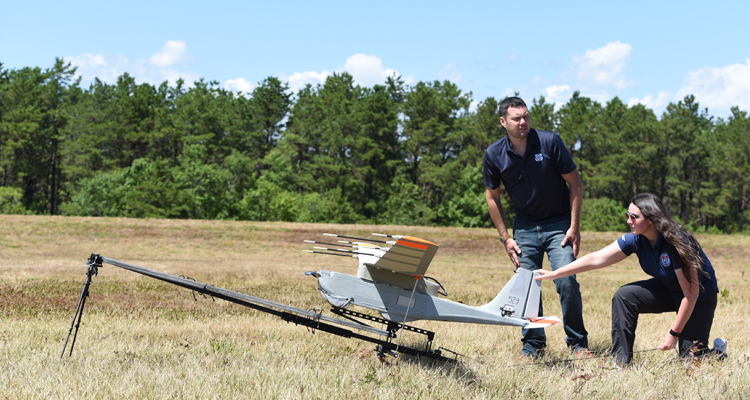March 3, 2021 —

Aviation Branch personnel Evan Gross and Taylor Kall from the Coast Guard Research and Development Center prepare an AeroVironment Puma unmanned aircraft system equipped with the Passive Acoustic Non Cooperative Aircraft Collision Avoidance System for launch at Air Station Cape Cod, Massachusetts. U.S. Coast Guard photo.
The Coast Guard Research and Development Center (RDC) is evaluating Detect and Avoid (DAA) technologies to enable unmanned aircraft systems (UAS) to operate Beyond Visual Line of Sight (BVLOS) without relying on Coast Guard cutter systems for clearing airspace.
Current Federal Aviation Administration (FAA) rules prohibit UAS in national airspace under visual flight rules because UAS cannot detect and avoid other aircraft. DAA technologies may provide one solution to meet national airspace requirements, allowing the Coast Guard to expand its use of UAS to maintain better awareness of activities in the maritime domain.
“The ultimate goal of this project is to provide a pathway for UAS to operate BVLOS for both flight deck-equipped cutters and smaller vessels without a flight deck, providing a tool to increase mission effectiveness for Coast Guard surface operations,” said Steve Dunn, a researcher with the RDC Aviation Branch who is leading this effort.
In addition to supporting operation of UAS to cover greater distances at sea and patrol operational areas from land-based stations, DAA/BVLOS technology could increase Coast Guard efficiency by eliminating the need for a dedicated air direction controller to keep UAS clear of other aircraft.
Acoustic signature system
The RDC evaluated a DAA acoustic signature system called Passive Acoustic Non Cooperative Aircraft Collision Avoidance System (PANCAS) in August 2020 at Air Station Cape Cod, Massachusetts. The objective was to capture audible range data on how far the UAS could detect other aircraft to support future commands for UAS operators to avoid other airborne targets.
The PANCAS technology uses sound rather than radar and computer vision to detect things in its airspace. It has the potential to be used by UAS operators located on cutters or at land-based units, covering the full range of UAS operations.
PANCAS looks for an acoustic signature to identify aircraft in its vicinity and alert the UAS operator, who can then take evasive action to avoid the other aircraft. This equipment is also an example of a passive technology, meaning it is constantly listening for an acoustic signature and has 360 degree listening range. This technology may prove to be an alternative to active transmitters, which may not have 360 field of view and possibly require a lot of power from the UAS’s limited power supply.
The PANCAS evaluation was very successful; however, the technology is not at the stage where it can be submitted to the FAA for approvals. Additional engineering will be done to integrate waterproof microphones into the UAS wing, enabling the system to land in the water.

An AeroVironment prototype long-range directional antenna (left) was evaluated for its ability to extend the range of UAS operations using ground control stations at Air Station Cape Cod and onboard a Station Cape Cod Canal response boat (right). U.S. Coast Guard photo.
Long-range directional antenna
The RDC utilized a Cooperative Research and Development Agreement in November 2020 to evaluate a long-range directional antenna developed to extend the operational range of an AeroVironment Puma UAS. With the antenna, the RDC was able to successfully operate the Puma out to a range of 31 nautical miles. For this evaluation, the RDC team established two ground control stations -- one land-based unit at Air Station Cape Cod and one onboard a response boat from Coast Guard Station Cape Cod Canal.
The evaluation was successful and proved the antenna’s viability for ground-based operations; data gathered will help support future BVLOS operations using DAA technologies. The demonstration also validated the need for a 360-degree directional antenna for BVLOS operations by the Coast Guard boating community. The RDC team is investigating further partnerships involving directional antennas to provide that capability.
The ability to operate smaller UAS such as a Puma farther away from Coast Guard vessels may unlock the full potential of UAS, providing a force multiplier for non-flight deck equipped cutters. Extending the range and flight time of smaller UAS are key factors for operating BVLOS.
What’s on the horizon?
Future evaluations will be focused on two capabilities:
- Investigating DAA technologies incorporated onboard a long endurance UAS capable of operating for 6.5 hours. This effort will support future UAS operations with Coast Guard vessels not equipped with a flight deck.
- Evaluating vertical takeoff and landing UAS equipped with DAA technologies for operating onboard cutters with a flight deck.
The goal of both efforts is to obtain an FAA Certificate of Authorization to use DAA technologies for operating BVLOS. The RDC plans to continue evaluations through early 2023; however, schedules may be impacted by COVID-related travel restrictions.

Puma UAS equipped with PANCAS flying with an Air Station Cape Cod HC-144. U.S. Coast Guard photo.
For more information: Research, Development, Test and Evaluation program page and Research and Development Center page.